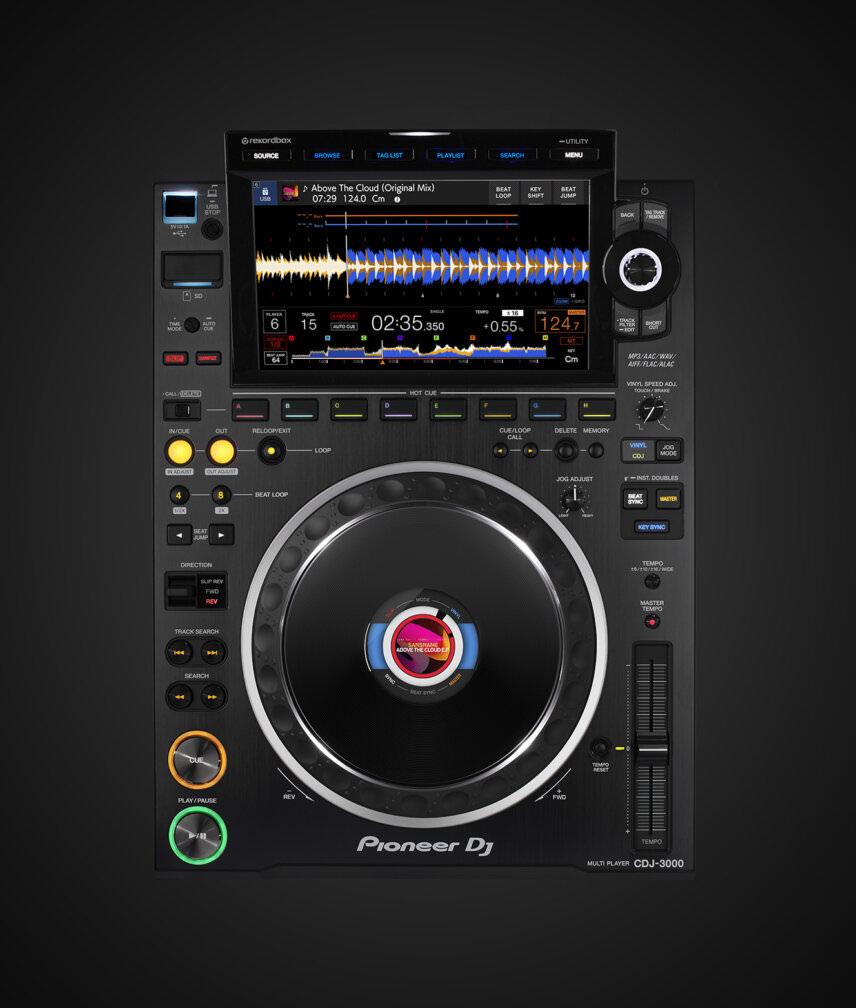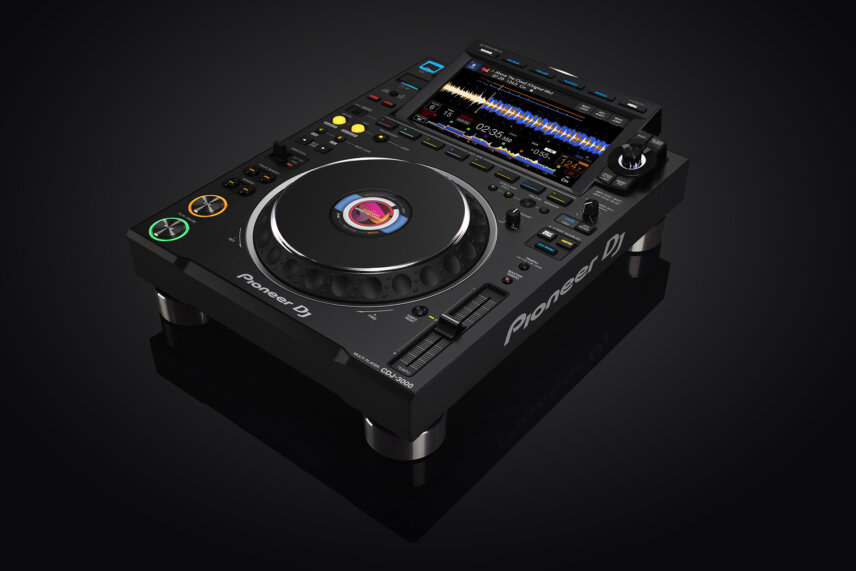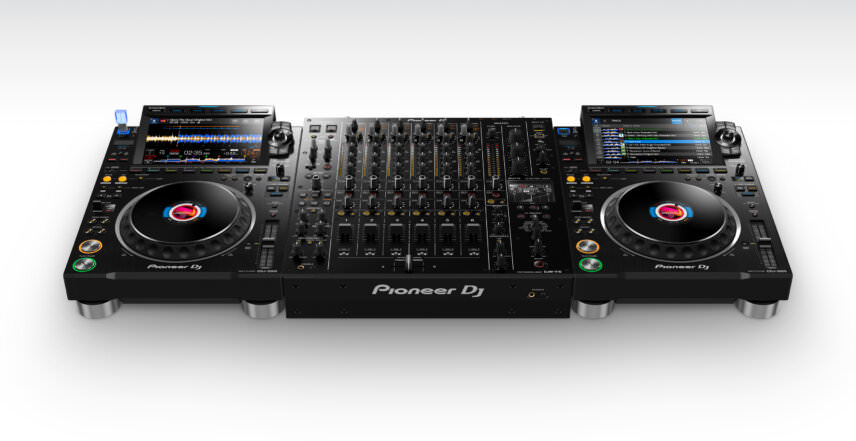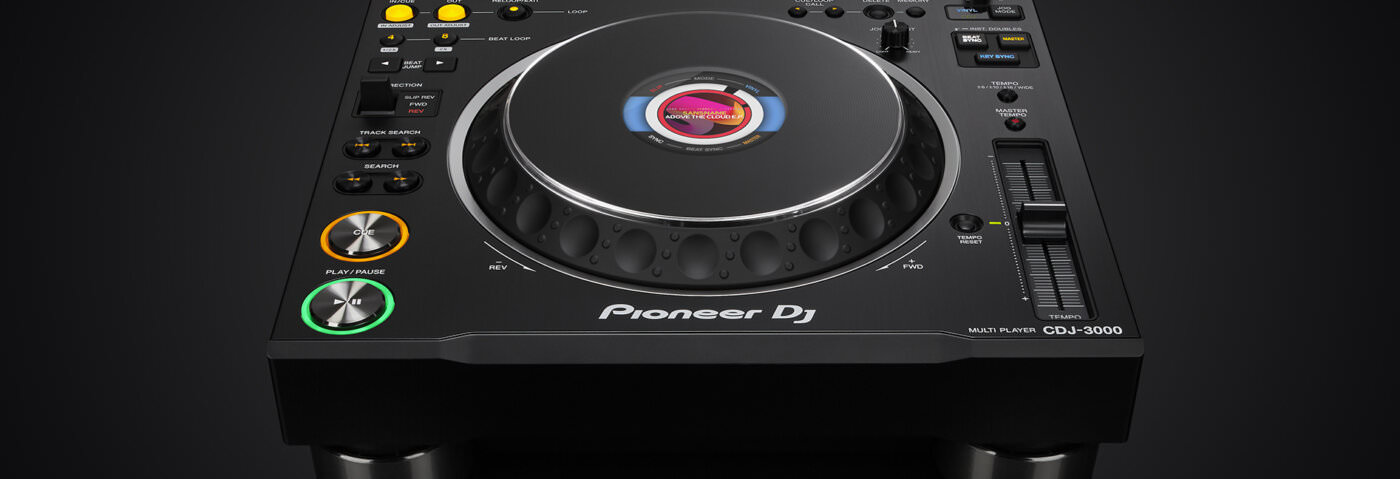With the CDJ’s ubiquity in clubland, and at this price point, it was always going to create a stir. We jump into the mix and review Pioneer DJ’s new flagship media player, the CDJ-3000.
Overview
In an increasingly competitive space, Pioneer DJ last month released the CDJ-3000. Following on from the evergreen CDJ-2000 was always going to be a challenge as they have become industry standard in DJ booths worldwide in much the same way that Technics 1200s and 1210s were for the vinyl era,
For readers who may not know, Pioneer’s CDJs used to be CD players, but the latest incarnation don’t actually play CDs. Instead, you can think of them as digital multi-media players with enhanced creative options. Because digital music is extremely malleable, DJ decks are now far more than simply playback machines.
The CDJ-3000 plays music from a variety of digital sources and allows users to manipulate the audio in various ways. It’s not a musical instrument, but it’s no longer a simple playback device either, as it comes equipped with the functionality to facilitate live re-editing, beat juggling and simple re-mixing as well as seamless transitions.

Price
Let’s address the elephant on the dance floor and get it out the way. We know many will scroll to price first and then read the features after…! Retailing at £2,169 for a single player, a mouth watering £4K plus for a pair, there has been plenty of talk online about the cost of these machines, particularly in the context of a global pandemic in which club culture has been hit extremely hard.
Putting aside the instant frustration over the price for a moment, it’s worth remembering that the design and marketing schedule for products like these are planned years in advance. While the release of a CDJ costing over 2K may appear insensitive in 2020, it’s possible that it was unavoidable for a company who have spent years developing it and who have targets to hit (pandemic or not).
It would also appear from the price that Pioneer DJ are content for the moment to mainly cater to the venues and professional end of the DJ market rather than the home or casual users. It’s easy to balk at prices, and while we would never recommend a financial outlay of this size without careful consideration, it’s definitely worth trying to understand why/how they cost what they do.
New Features
The thing about modifying an industry-standard – particularly one that is used in the dark, in high-stress situations – is that the users may well welcome new features, but also, they don’t want to be faced with an unfamiliar interface when they arrive at work. So the changes need to be intuitive and somehow integrated into the existing interface.
Straight away you can see that there are additions and changes but that the basic set up of central platter, pitch control on the right, screen at the top and the main cue buttons bottom left remains the same. The most noticeable changes are that the screen is bigger and brighter, the cue buttons have doubled from four to eight and are now located directly below the main screen.
The audio source buttons that used to be to the left of the main screen have gone completely and you can now also see the release artwork on a circular screen on the platter – a super useful addition, providing a visual cue to help aid memory in the same way vinyl record sleeves used to. But the main things that you’ll want to see when you’re trying to mix in your first tune at 4 am and the smoke machine’s been on full for half an hour, they are all where they should be.
Will the features make for boring sets? No. They’re just tools and a good DJ will use them well and a bad DJ won’t.
Other improvements and additions to the CDJ-3000 include the addition of an advanced micro-processing unit (MPS) which increases functionality whilst also maintaining stability. Certainly, during this test there were absolutely no issues with either functionality or stability.
The 3000 also comes with Pro DJ Link with Gigabit Ethernet meaning you can play on up to 6 CDJs at once from USB or SD. Pioneer DJ have added stacked waveforms to the screen which means that you can see waveforms of both the tunes you’re mixing together at the same time. They’ve improved the jog wheel’s smoothness, added new functionality to the touch screen including touch preview, substantially enhanced the loop section and added dedicated beat jump buttons.
Setting Up
Setting up the CDJs straight out of the box is easy – a single digital out from each deck to the mixer and a single link cable between both decks and you’re away. Playlists from Rekordbox were instantly available and there was no linking or connection issues at all. On the subject of connections, a number of hardware improvements have been made including the welcome addition of a lockable V-Lock power cable to prevent accidentally power cord removal.

In terms of build quality, the top plate is now aluminium and the play, cue and Hot Cut buttons have been made way more resilient to continued use. Pioneer DJ say that the cue buttons have been tested to receive “over 1 million button pushes without damage” so if you want to use the main cue button as a drum pad DJEZ style then you should be ok for a while.
So out of these various additions, we’re going to look a bit closer at the modifications to the controls and additions which aim to aid DJ performance: the hot cue buttons, expanded looping section, dedicated beat jump buttons and the key sync and key shift functions.
Hot Cue Buttons
There are now eight coloured hot cue buttons that sit directly below the waveform image on the screen. The thinking behind this is that it’s way more intuitive to have them directly below the waveform so you can make the cues match up to either the start, middle or end of the song.

It is definitely a more intuitive placing and having a bank of eight is more useable than the eight cues accessible by four buttons on previous models. Setting them up and deleting them is easy and if you know the track you’re cueing up well, you can set up a tasty live re-edit in your headphones in next to no time.
Expanded Loop Section
Pioneer DJ have increased the possible loop length to 8 bars which is a welcome addition. The most interesting change in the loops section though is the uneven loop lengths. James Zabelia has demonstrated how he uses this to seamlessly transition between music with vastly differing tempos but it’s also superb for creating polyrhythms. Layering a three-bar percussive loop – it works particularly well on rhythm tracks with no snare or clap on the two and the four – on top of a track with a standard time signature can sound superb – slightly wonky but also perfectly in sync.
Switching between loop lengths via the touch screen is super-intuitive although once you start looping both machines and then getting into 3 bar and 5 bar loops it’s easy to get lost. But there is potential for interesting rhythmic invention here, and for the creation of some mind-mashing dance floor moments in the mix, particularly once you also take the dedicated beat jump buttons into account too.
Beat Jump Buttons
The beat jump buttons are a big new feature. They enable you to smoothly jump backwards or forwards by a specified number of beats. This means that you can now beat juggle between a pair of tunes with relative ease. Luckily for both DJs and punters, Pioneer DJ have included a dedicated quantise button to keep all the cues, beat jumps and loops snapped to the grid.
Key Sync
In addition to the Beat Sync function, Pioneer DJ have now added Key Sync. This analyses the audio, identifies what musical key it is in and then pulls the next track into a complementary key in order to prevent musically mismatched transitions. What’s interesting about the 3000’s Key Sync is that it ‘considers’ a number of harmonic options before deciding on the one which uses the least pitch-shifting as possible. This is to address the problems that can arise from large amounts of pitch-shifting; distortion, aliasing, vocals that sound ‘chipmunk’-y or that turn from a sweet female voice into Barry White.
Pioneer’s Key Sync technology therefore attempts to use as little pitch-shifting as possible, generally + or -2 semitones. So if the track playing is in Ab minor and the next tracks in E minor, Key Sync will move the E minor tune to Eb minor which is a complementary key, rather than moving it all the way to Ab minor.
If you want to use the main cue button as a drum pad DJEZ style then you should be ok for a while.
In DJing terms, the results are generally great. Certainly, if you’re mixing harmonically rich non-vocal tunes together it can really make a difference in getting a pair of tunes to sit together. As with any pitch shifting adjustments, inevitably once you start to move the human voice too far from its original pitch it becomes very noticeable and this is certainly the case with Key Sync. Just because you can pull the incoming track down by a couple of semi-tones to make it fit musically with the tune you’re currently playing, doesn’t mean you’d actually want to, not if it makes the vocal on the tune coming in sound weird. Key Sync is a useful tool for certain sorts of music at certain times, and it’s good to have the option to instantly key match stuff, but I would definitely not leave it on all the time.



There’s also the issue that some DJs will inevitably raise that Key Sync will create homogenous, boring sets. My view on this issue has always been the same, whether we’re talking about Key Sync, Beat Sync, digital mixers, whatever: they’re just tools and a good DJ will use them well and a bad DJ won’t.
Key Shift
The Key Shift screen extends the Key Sync function and is a great feature for the more creative DJ. Enter the sub-menu and you’ll be able to pull your audio into any key by semi-tones in either direction. So rather than automatically suggesting complementary keys, Key Shift allows the DJ to use their ears and choose for themselves. What does it sound like? Initially impressive, although you’d really need to hear it on a club system to test it thoroughly. Again, the further away from the original key you go, the less good it sounds, but this will be super-useful for DJs who use acapellas or who create mash-ups live. It will also be useful when you don’t agree with the Key Sync or perhaps want to maybe move both tracks a semitone or two to get them to fit together rather than just Key Sync one to another.
How does it sound
As you would expect for a machine at this price point, the sound is excellent. Pioneer SJ have made much of their improvements under the bonnet including substantial improvements to the digital-to-analog converter and reduction of digital noise. For DJs using the various pitch shift and key sync functions, the big issue around sound is always aliasing once the pitch is moved substantially from its original key. On older models, many DJs could hear audible bass ‘wobbles’ and ‘wavers’ when the Master Tempo was switched in and big pitch adjustments were made – and this does appear to have been successfully addressed on the 3000.


Last Track of The Night
There’s nothing similar from other manufacturers at this price point. At the less expensive end of the market, the Denon SC6000 offers similar functionality – dedicated beat jumping, visual display on the jog wheel, pitch adjustment software, big waveform screen etc. – but for around £1000 less. And the Denon also comes with dual-layer capability, performance pads and streaming or cloud access, none of which you get with the 3000 – although the new MPU potentially makes the 3000 open to future upgrades.
What you get for your money with the Pioneer CDJ-3000 is superior build quality and components. Pioneer have made a substantial commitment to improved sound quality, both for standard and also for pitch-shifted playback, with particular attention paid to the low end, and in doing so are positioning themselves as the professional unit for the night club industry. They’ve also added enough DJ functionality to keep creative DJs happy. A pair of these in tandem with a decent mixer and a DJ will be extremely well equipped.
The price tag will mean that few DJs are going to have a pair of CJD-3000s in their homes, but at the moment, it seems unlikely that clubs are going to replace their Pioneer DJ decks with other brands – so for the time being at least, pro DJ booths are going to have Pioneer DJ decks in them. Luckily, for working DJs, the CDJ-3000 is, like its predecessors, an absolute joy to work on.
The Verdict
Price: £2,179
The Final Word
Like its predecessors, an absolute joy to work on. Bring on the return of the clubs.
While you’re here
We thought you may like our…

